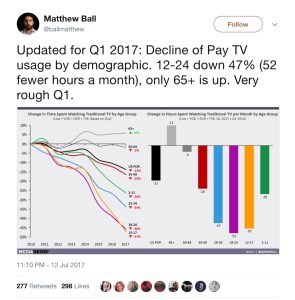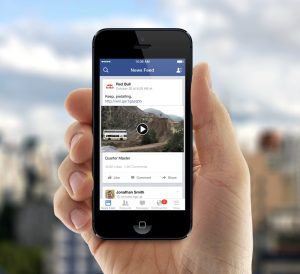How we reached here?
 With every passing minute, people are switching to streaming media content in comparison to traditional cable tv networks. This switch is quite apparent in countries with good network infrastructure, as compared to the ones with relatively low-speed. Taking the example of US, the number of hours spent watching TV has vastly decreased in all age-groups, except the old age (65+ group), according to Matthew Ball, Amazon studios.
With every passing minute, people are switching to streaming media content in comparison to traditional cable tv networks. This switch is quite apparent in countries with good network infrastructure, as compared to the ones with relatively low-speed. Taking the example of US, the number of hours spent watching TV has vastly decreased in all age-groups, except the old age (65+ group), according to Matthew Ball, Amazon studios.
Only senior age group in the last 7 years have shown an increase in the number of hours watching cable TV, while every other age-group shows a decline especially the groups below 35 years. What this means is, lesser the number of people tuning-in to TV, the less exposure the advertisers get from TV ads and hence a declining cable TV industry on its way. Todays generation especially millenials have started to shun cable tv and prefer watching videos on streaming channels. This brings the ad-revenue battle in a ground where Youtube has been a dominant player. Lets discuss what is at stake and who can challenge youtube at its territory.
When Billion$ of AD Revenue are at stake!
When talking about advertising on internet, there are essentially only two contenders, Alphabet (who owns Google & Youtube) and Facebook. According to research firm, e-marketer these two are expected to take half of world-wide ad revenue, and more than 60% in US alone. The scale and volumes of revenue they will get, tells the whole story about why they will be in war. Future is not so friendly for these two, when billions of ad-dollars are at stake. To dominate the ad-space, both platforms are putting their best effort to onboard the most number of channels, the advertisers will go to. If you look through each of them closely, you will know some hard facts;
- Google owns about 90% of the network of websites that matter the most for ad-revenue.
- Facebook boasts 2 billion active users a month.
Numbers speak for themselves!
According to Michael Delpierre from Conversion Pipeline – a digital marketing agency, Every day on google, there are around 3 billion searches done per day, which is an astounding number. If you were to pick a platform to deliver your advertisements in a smart way – as google does, why would you choose any other option. In contrast, the case of Facebook is different, it’s a social network where they know almost every personal detail of a user they want to target (unless the customer is using bunch of privacy filters, which doesn’t happen that often). Both the contenders have covered their markets in big numbers. Still hard to pinpoint, who will win? Let’s put some more clarity in it.
When it comes to delivering ADs on any of the two platforms, Google owns the most diverse number of services to deliver the ADs, starting from search advertising – remember 3 billion searches per day! and that is just one example, then there is video ads on Youtube. The options are just too many and the Alphabet’s products stack and ad-delivery platforms are too strong. While on Facebook side, the main weapon is the killer News Feed – it just owns every thing in the world right now. No wonder, the News Feed bring them billions of dollars and all from ad-revenue now. When talking about spending money on Ads, advertisers mostly incline towards platforms, that creates the best user experience, is engaging, and more-or-so in an image or video format. Yes, text is too boring! Look at Twitter’s revenues, let’s just move on, talk about something serious!
Clash of Video Platforms
Both Youtube and Facebook, by the end of 2016, pulled 5.6 billion USD of ad revenues
The increase in online video content has exploded in the last few years. According to Kleiner Perkins, just in 2017 video content delivery will account for 74% of the total internet traffic and by 2019 it will reach more than 80%. Both Youtube and Facebook being the biggest platforms for video delivery boasts an astounding more than 1 Billion daily active users. Here are some numbers that show the strength of the two platforms
- YouTube has over one billion users – almost one third of all Internet users and every day billions of hours of video is watched
- YouTube overall (including mobile), reaches more 18–34 and 18–49-year-olds than any cable network in the US.
- More than half of YouTube views come from mobile devices.
- By the end of 2016, Youtube pulled more than $5.6 Billion in ad-revenues (similar to Facebook).
- Youtube – being the video platform is mostly preferred for medium to long video formats
- 6 billion hours of video is watched every month
- The local YouTube version can be used in more than 88 countries.
- YouTube is available in a total of 76 languages (covering 95% of Internet users)
Facebook in Numbers
- 1.32 billion daily active users on average for June 2017
- 2.01 billion monthly active users as of June 30, 2017
- Facebook counts one-view after 3 seconds and its famous auto-plays without sound accounts for 85% of the videos.
- Similar to Youtube, by the end of 2016, Facebook also pulled more than $5.6 Billion in ad-revenues
- Facebook, which organizes all the content in the users news feed (previously Facebook Wall), try to mixin content that suits best for text and videos. Content creators mostly prefer videos on facebook that are short clips and not lengthy videos in order to attract the attention of users in the feed, especially mobile based news feed.
Both are competing aggressively to keep their user base intact and further build up their numbers by onboarding more and more video content creators by supporting their community. At the same time Facebook has launched its latest Facebook Watch tab, which is a new contender to tap-in the longer video formats space. Naturally the ad-revenue is split among content partners and facebook similar to Netflix. Video content being the king, Facebook knows that users will get more engaging content on their news feed, hence an incentive for them to be more active – boosting company’s ad-revenue. According to Mark Zuckerburg,
You’ll be able to chat and connect with people during an episode, and join groups with people who like the same shows afterwards to build community.
Figure shows Facebook’s new video service called Watch, its only live in few US regions
Facebook Watch is personalized with your taste; just like current News Feed is adapted to your taste. It brings you shows that your friends are watching and mostly discussing about. In contrast to Youtube, where the social angle with video content sharing is missing, Facebook has completely nailed this angle and will hit the ad-revenues of Youtube badly.
At the end of the day there are only two types of people that are spending money,
- The end-customers who buy the product advertised on these video platforms, and
- The advertisers who pay money to these platforms to attract the above end-customers.
Now, the platform that can give the best return on investment to advertisers will be the one who brings in the most paying end-customers. Both platforms provide almost comparable sizes of end-customers i.e. in billions but the nature of content on these platforms is not so similar. Youtube contains everything from small funny clips to Hollywood movies while Facebook Watch has only launched with ‘shows’ in mind which is a smaller and a subset of the youtube’s target market. We can only speculate at this point that Watch will extend its service to other content as well but at this point in time we can safely say that the edge of social interaction goes with new Facebook Watch that can bring the reigns of leading video platform for ad-revenues from Youtube to Facebook in the coming years. Time will tell!
You decide!
Share your thoughts in the comment section below, who you think will be the leader in the coming years, Youtube or Facebook Watch?












